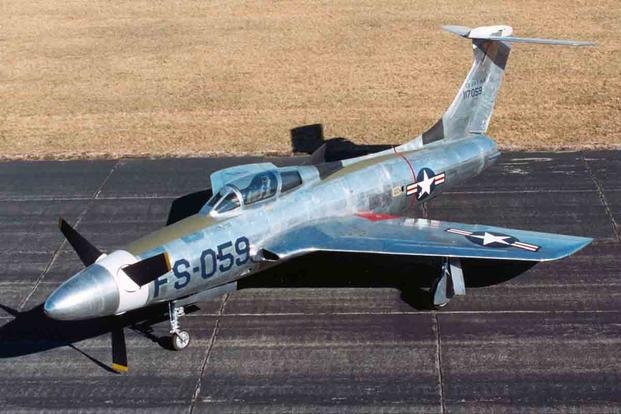In the early 1950s, the U.S. Navy needed a carrier-based aircraft that could take off without the help of a catapult. What came out of that order was an Air Force plane with a propeller that spun faster than the speed of sound -- and the loudest aircraft ever constructed.
The Navy eventually dropped its order (for the time being, anyway), and the Air Force was left with an experimental airplane that caused a continuous stream of sonic booms from its propeller. The loud noises caused the ground crews that worked on the plane to vomit and have seizures.
With friendly aircraft like that, who needs an enemy?
When the Navy first started looking for its catapult-free airplane, the Republic Aviation Corporation began looking into what it could do to get the contract. It sought the help of the Air Force's Wright Air Development Center in Dayton, Ohio, the USAF's primary aircraft acquisition and testing arm (its public one, anyway).
They developed a version of the F-84 Thunderstreak that was powered by a turbine engine and supersonic propeller. Called the XF-84H, the project was riddled with problems from the start. For starters, the supersonic propeller created enough torque and propeller wash to destabilize the plane in flight. Even Republic Aviation referred to the engine as "a monstrosity, a mechanical nightmare."
One might be thinking about why the Air Force would be interested in building a prop plane in the age of jet aircraft. They had hoped to create an aircraft that could fly as fast as a jet while giving the pilot a responsive plane that propellers provided.
The airplane would never fly supersonic, but that doesn't mean it was slow. It was able to handle like a prop plane and give the pilot the acceleration the Navy needed to get planes off a carrier without a catapult. That's where the list of "pros" ends for this particular plane.
Engine failures caused by the propeller's vibrations ended 10 of its 11 test flights due to mechanical issues. It would have been useless as a fighter aircraft, because despite its powerful acceleration, it took 30 minutes to prepare for flight. In that time, the ground crews servicing the plane would have their work cut out for them.
XF-84 ground crews nicknamed the plane "Thunderscreech," a play on the nickname of the operation F-84 fighter bomber, because it was so loud. The propeller tips of the XF-84 traveled at Mach 1.18, faster than the speed of sound, producing sonic booms that could be heard some 25 miles away.
The noise combined with the shock waves of the booms were enough to effectively cripple the area and any crewmen who might be in it. Crews would have to endure while the XF-84 was powering up for 30 minutes before takeoff.
One unlucky C-47 Skytrain crew chief who happened to be in the area while a Thunderscreech was powering suffered a seizure in the back of his aircraft due to the intensity coming out of the XF-84.

When it finally rolled out to Edwards Air Force Base's testing areas in 1955, none of these problems had been addressed. Republic Aircraft Company test pilots would refuse to fly in it, and the Edwards AFB tower was concerned the plane would shatter its windows.
Only three prototypes were ever made for the XF-84, and its engine was the most powerful on the planet at the time. It's also still the loudest aircraft ever built, which just goes to show that bigger and more powerful isn't necessarily better.
-- Blake Stilwell can be reached at blake.stilwell@military.com. He can also be found on Twitter @blakestilwell or on Facebook.
Want to Learn More About Military Life?
Whether you're thinking of joining the military, looking for post-military careers or keeping up with military life and benefits, Military.com has you covered. Subscribe to Military.com to have military news, updates and resources delivered directly to your inbox.
















